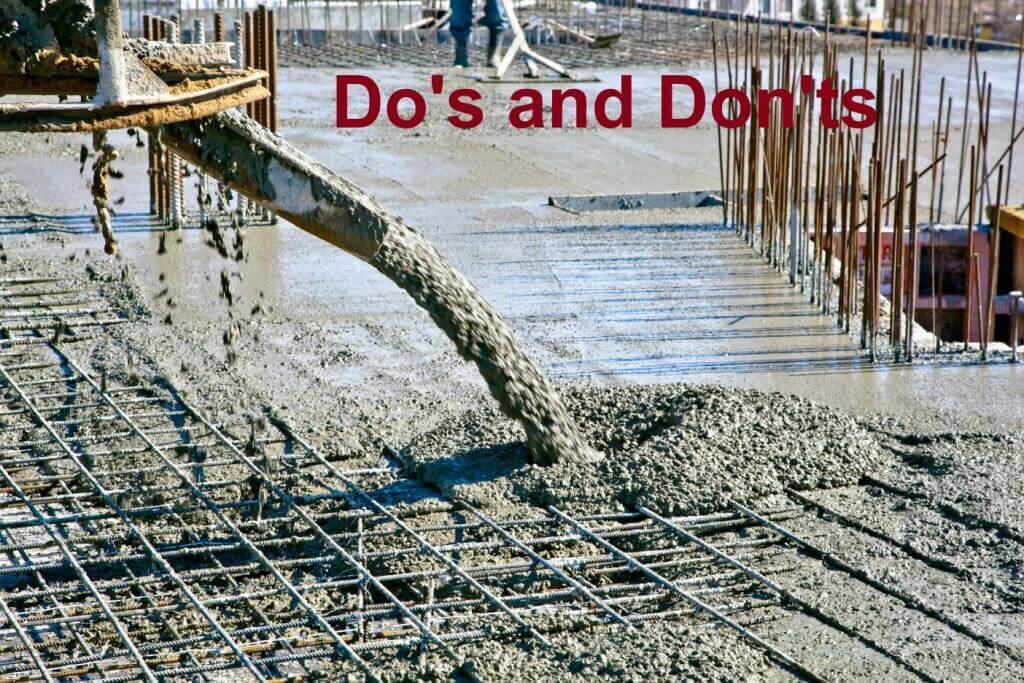Concrete is a complex construction material consisting of different ingredients, which have different functions. The properties of concrete depend on the particular mixture of constituents. The basic constituents used to make concrete are cement, lime, water, aggregates, and admixtures.
Your concreting work can be successful if it involves a good planning and right practices. Most of the repair and maintenance problems may occur in the building due to bad practices in concrete construction. These following Do’s and Don’ts will make your concreting job very easy.

Do’s:
01. Do hire an experienced Concrete contractor for successful concreting operation.
02. Also, see that the main/general contractor hire good skilled sub/labour contractor for concreting.
03. See that concreting is done under skilled supervision. Never leave it to labour on site.
04. Always wear suitable PPE (Personal Protective Equipment)before casting concrete.
05. Start placement of concrete with adequate manpower, proper equipment and tools.
06. Always choose right cement for the particular job. If you have confusion, ask the technical person.
07. Always pour the concrete when the weather conditions are favourable.
08. Suitable mix design should be used for particular specifications (i.e. M25, M30 etc.).
09. Choose right concrete mix as per specifications.
10. First mix the dry concrete uniformly i.e. cement, coarse aggregates, fine aggregates (either manually or in transit mixture) as per predetermined quantity (i.e. batching of concrete materials). A good concrete contractor will always mix the dry concrete first.
11. Add water as per predetermined quantity only.Always measure the water with measuring container before adding in concrete.
12. Mix the wet concrete thoroughly for around 2 minutes to get the consistent concrete.
13. Do slump test before placing the concrete.
14. Concrete must be placed within 15 to 20 minutes of pouring water. If delayed add fresh cement or concern the consultant.
15. Do the proper compaction to the concrete with a vibrator or wooden tamp to remove air from the concrete. If compaction is not well, it will create voids/honeycomb in concrete resulting in leakages from the concrete structure, thereby causing corrosion and also reducing the strength. This also affects the life of the structure.
16. Pour the concrete throughout in an even thickness.
17. Always keep on checking the stability of props/ supports of formwork below.
18. See that the covers insert doesn’t get displaced.
19. Finish the surface and edges of concrete after placing of concrete using with trowels or wooden floats or metal floats. Ensure that the concrete is finished in the same direction when trowelling.
20. Do proper finishing at joints during concrete construction.
21. Give attention towards the bleeding in concrete. Water should not evaporate rapidly.
22. Calculate the number of cement bags concreted per hour. If more than 25 to 30 bags are used per hour, then mixing time allowed is less and it should not be permitted (For 1 bag mixture machine).
23. See that no one walks on the concrete surface till the concrete gets hardened.
24. Do proper curing when the concrete has hardened initially. We have already discussed different types of curing methods. Start curing after 6 to 10 hours.
Don’ts:

01. Don’t use damaged formwork. It affects the concrete resulting in the honeycomb.
02. Don’t use unwashed aggregates in concrete; it may result in a weak concrete and substantial cost of maintenance.
03. Don’t start concreting before casting of a concrete cube. The Strength of the concrete should be as per predetermined mix design.
04. Don’t go for volumetric batching. Never allow the use of gamellas.
05. Don’t use high concrete slump, excessively high air content, or excessive fines.
06. Don’t run concrete mixer more than two minutes resulting in segregation of concrete constituents.
07. Don’t add more water for ease of placement during the making of concrete.
08. Don’t use semi-dry concrete in pouring. There will be chances of honeycomb inside the concrete.
09. Don’t drop concrete form greater height as this will cause segregation.
10. Don’t allow heaping of concrete at one place during pouring.
11. Don’t vibrate the concrete after the initial setting has taken place. (i.e. after 30 minutes)
12. Don’t finish the concrete while bleeding is present on the surface of the concrete.
13. Unless must and unavoidable, never do concreting at night. The lighting arrangements are never adequate at all work places and hence some errors can always happen somewhere.
14. Don’t remove formwork until the concrete has gained sufficient strength.
15. When finishing of the concrete is carried out, never throw or sprinkle the water on to the concrete surface.
16. Don’t try to finish the dried concrete.
17. Don’t do concreting if it is raining heavily
18. Never allow child labour on site. You will land in jail for violence of law.
